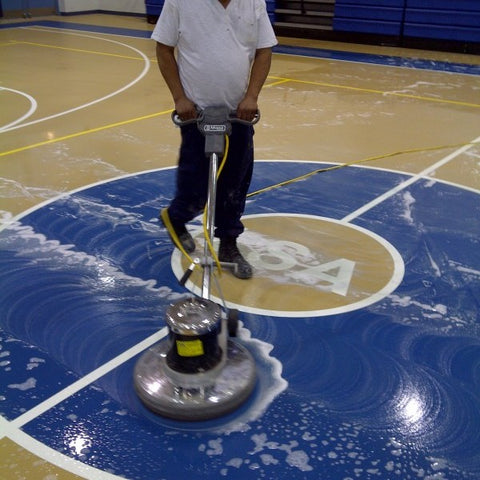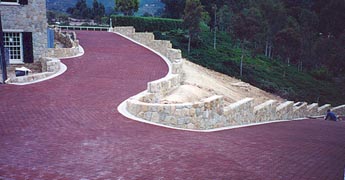What Factors Contribute to a Slippery Floor?
Factor A: Presence of Dust or Grit
If a floor is not properly dust mopped or swept, the residual dust can provide a barrier between the floor and shoe. Unfortunately, the dust moves under foot traffic. In a sports environment, the presence of dust is a serious problem because these activities are more intense and forceful than normal foot traffic. Thus, poor dry soil removal will create a slippery floor faster than on a typical floor. Needless to say, this phenomenon makes it imperative that these floors have a frequent and effective dust control program.

How to Fix It: Effective Dust Control Program
1. Entrance Matting – It is important to have effective matting placed at each of the entrances onto your sports floors. This measure will prevent some of the dry soil that could enter onto the floor. Preventative maintenance is usually the most cost effective measure to a cleaning maintenance program.
2. Frequent Dust Mopping – Daily dust mopping is critical to removing the dry grit and dust that is on the floor. It is preferred that a treated dust mop is used because the dust mop treatment will improve the effectiveness of the dust mopping process. If traffic is heavy, it may be necessary to dust mop the floor more than daily.
3. Check Vents and HVAC Systems – In rare situations, dust can come from the vent or air handling systems. If the vents or HVAC system cannot be cleaned, the cleaning frequencies need to be increased.
Factor B: Presence of a Film
Whenever moisture is presence, dry soils can become attached soils or films that are not removed by dry methods. It is necessary to use the proper cleaning chemicals and proper cleaning procedures to remove these films from the floors. The presence of any film on a sports floor can create a very slippery environment. Moisture from wet shoes is a common source for films that are present on floors. There are many other sources that can leave a film on a floor. If this film is not properly removed, the floor will remain slippery.
How to Fix It: Effective Wet Soil Removal
1. Proper Cleaning Chemical – It is important to use a safe yet effective cleaning chemical. A synthetic sports floor should be cleaned with a neutral floor cleaner (7 – 9 pH). At certain times, it may be necessary to use a more aggressive cleaner to remove the soils off the floor. When using a more aggressive cleaner, it is important to rinse the floor so that there is not a chemical residue left on the floor.
2. Use of an Automatic Scrubber – Because most synthetic floors have a high slip coefficient, soil removal can be difficult. The use of an automatic scrubber is a critical piece of equipment because it not only applies the cleaning chemical, but it also agitates the floor, which enhances the performance of the cleaner. It is important to use the least aggressive pad to clean the floor. Usually, white or red pads are usually recommended. Using anything more aggressive than a red pad may damage the floor. After the floor is scrubbed by the pads of the automatic scrubber, it is important that the cleaner is removed completely. Ineffective recovery of a cleaning solution will leave a film on the floor that can leave the floor slippery. It may be a good idea to periodically check the performance of the automatic scrubber. If there are questions about the performance of the automatic scrubber, consult a cleaning equipment service center that can perform the necessary maintenance that will guarantee the best performance of the machine.





Comments (0)
There are no comments for this article. Be the first one to leave a message!